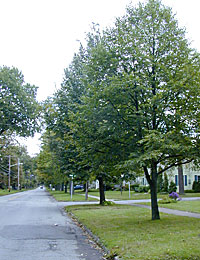Street Tree Project History
 Most community forests in New York State occur in smaller communities that often can not budget for the services of a dedicated urban forester. Typically, a member of the Department of Public Works is responsible for the care of community trees along with all other civic infrastructure. However, if seen as a group, these smaller communities comprise a significant portion of New York State street trees. The Cornell Cooperative Extension Program Work Team on Community Forestry felt that these communities were being underserved by urban forestry professionals and extension due to the lack of a mechanism to engage them in a proactive urban forestry management process.
Most community forests in New York State occur in smaller communities that often can not budget for the services of a dedicated urban forester. Typically, a member of the Department of Public Works is responsible for the care of community trees along with all other civic infrastructure. However, if seen as a group, these smaller communities comprise a significant portion of New York State street trees. The Cornell Cooperative Extension Program Work Team on Community Forestry felt that these communities were being underserved by urban forestry professionals and extension due to the lack of a mechanism to engage them in a proactive urban forestry management process.
To address this problem, we developed a master planning process specifically targeted to communities who did not have a dedicated urban forester.
The elements of our master plan process included:
- Identifying communities interested in working with us
- Utilizing USDA Forest Service software to create a multi-user tree-inventorying program that would output to Excel or Access
- Utilizing USDA Forest Service software to quantify the environmental and aesthetic benefits provided by the community forest
- Training students and volunteers to collect inventory data using handheld Personal Digital Assistant computers (PDAs).
The project was piloted in 2002 with 13 students trained in early September by Nina Bassuk and Paul O'Connor at Cornell. The Village of Liverpool was inventoried on September 14 and 15, 2002, and the Village of Cobleskill was inventoried on September 21, 2002. All street trees and potential planting spaces were counted in each village. Data was analyzed and a workshop held on December 4th for officials in both pilot villages as well as other communities interested in the process for their own community. Communities learned about their urban forest resources and how to make decisions about community forestry goals and implementation strategies.
This approach to urban forestry management is unique in being able to incorporate multi-user PDA's and Forest Service models for determining environmental and aesthetic benefits provided by street trees in addition to more traditional inventory data. The support to carry out these pilot projects came primarily from the communities themselves.
Thirty-six communities have been inventoried by the Ithaca based Central New York SWAT Team since 2002. Twelve additional communities have been inventoried by a Hudson River Valley SWAT Team based in Dutchess County and composed of trained Master Gardeners, which is available to assist communities in that part of New York State.
To learn more about Hudson Valley SWAT, contact Stephanie Mallozzi at sdm10@cornell.edu
.
Back to Conducting a street tree inventory
© Copyright, Horticulture Section, School of Integrative Plant Science, Cornell University.